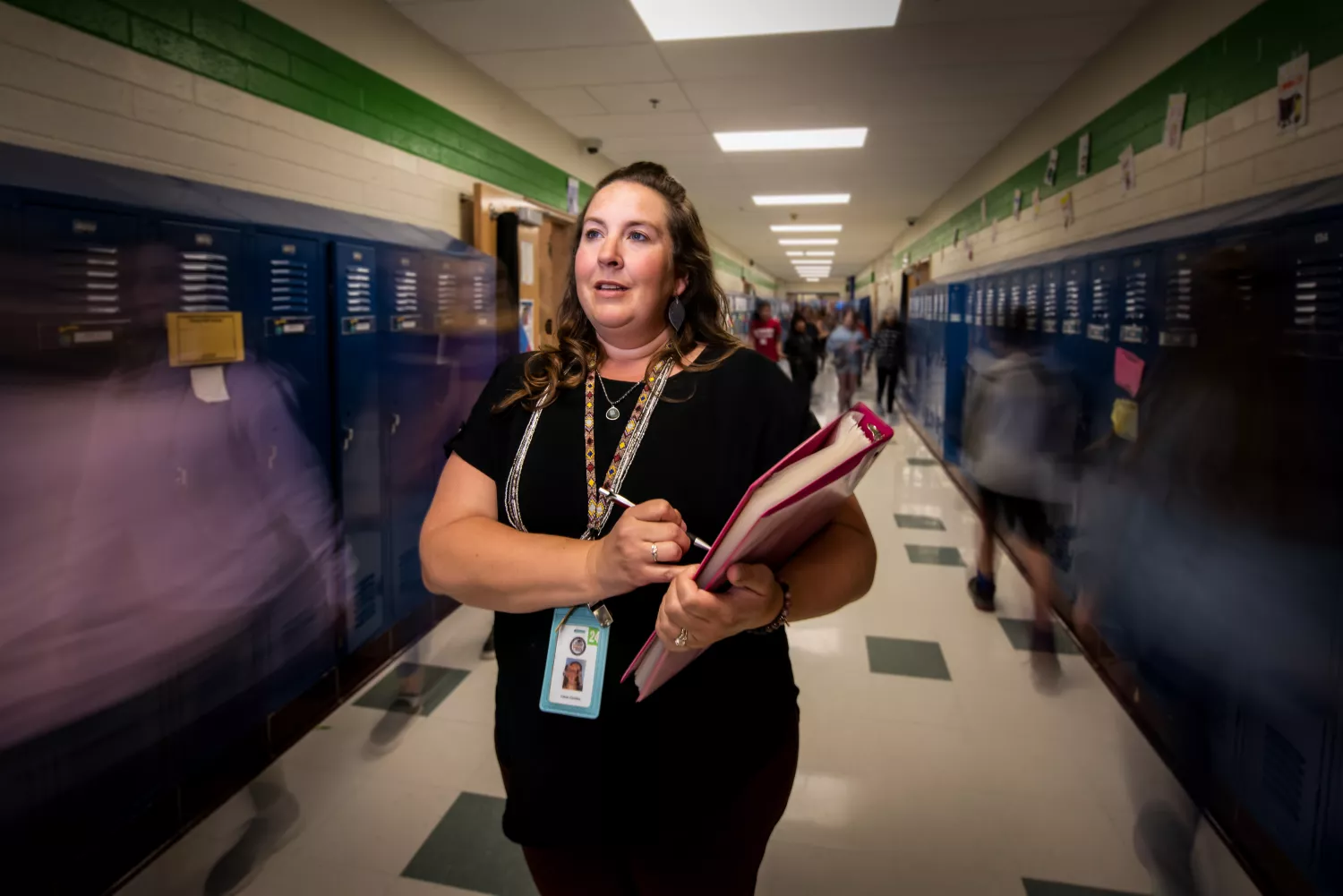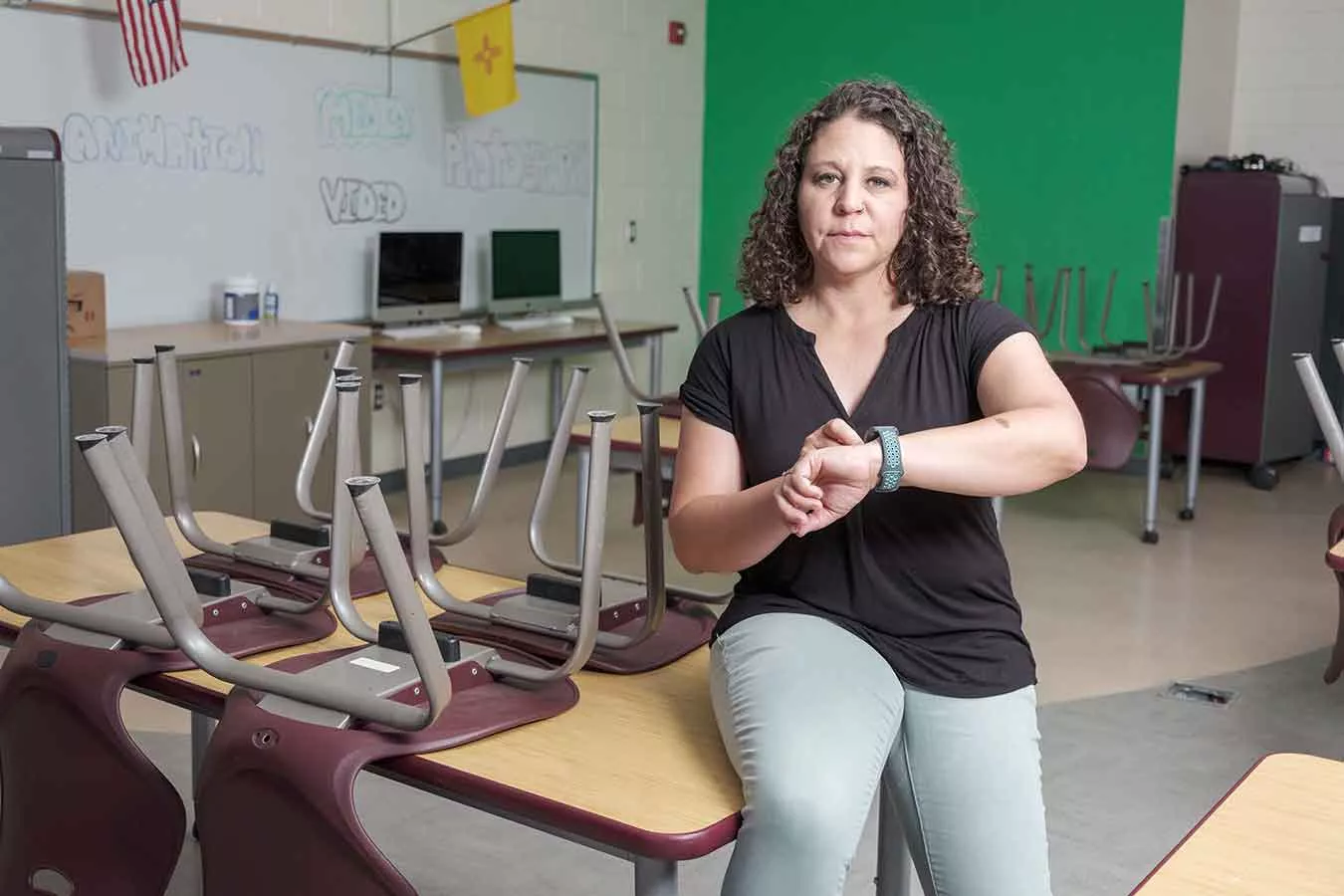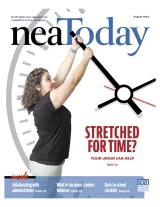Middle school teacher Natalia Fierro gets 50 minutes a day to plan lessons, run to the front office for supplies, call or email parents, analyze test data, do paperwork, maybe attend an IEP meeting, confer with school counselors or social workers, respond or reach out to administrators, chat with a student who might stop by, run a few hundred copies, go to the bathroom, wash her hands, and grade the papers of about 135 students.
“Is everybody feeling this tired?” asks Fierro, who teaches at Mesa Middle School, in Las Cruces, N.M. Yes, everybody is! Eighty-four percent of teachers don’t have enough time in their workday to get everything done, according to a 2024 Pew Research Center report. The reason? Their workloads are too heavy. According to new NEA research, on the average day, about half don’t have time for grading or planning lessons. More than 4 in 10 don’t even have time to eat lunch or go to the bathroom.
“I never feel satisfied at the end of the day that I have completed all my work. I’m not sure I even know what that feels like,” says Jared Washburn, who teaches AP English and creative writing at Red Land High School, near Harrisburg, Pa. Instead, Washburn takes work home every night, mostly piles of students’ papers to read and evaluate, and makes himself unavailable to his wife and son on Sunday afternoons.
“Work/life balance is sort of a mythical creature to me right now,” he says.
Why can’t teachers get everything done during their paid day?
98%
65%
72%
51%
What teachers are saying
It’s only getting worse, educators say. Students’ needs are increasing, parents’ demands are growing, and dictates on teachers’ time are multiplying.
These burdens are leading to burnout, which causes educators to quit, which feeds the national educator shortage, which, in turn, makes more work for the remaining staff.
The number-one reason teachers can’t get to their grading, lesson planning, or other essential work? Some 98 percent told Pew they simply have too much of it. Other reasons cited: Having to do non-teaching duties, like lunch duty; helping struggling students outside of class; and covering other classes.

The mandates around standardized tests are particularly infuriating, teachers say. And it’s not just the 16 days, on average, dedicated to test-taking, according to a Council of Great City Schools study. The bigger problem is the incessant demand to analyze that data and develop lesson plans targeting individual student’s deficiencies, according to a test they took weeks or months earlier.
“I prefer to teach according to the needs I see,” says Debbie Baker, a third-grade teacher in northwest Georgia, who actually has the highest test scores in her region.
5 Things You Can Do to Make Time
-
Learn to say no. “Honestly I don’t know if this is something I could have done when I was young,” says Cassie Gambler, an elementary teacher in Riverton, Wyo. “It’s probably something I learned more as I became a mom,” says the mother of three.
-
Figure out what matters less. For Georgia elementary teacher Debbie Baker, formal grades take a back seat. After 22 years, she knows her students are just as motivated by hand-drawn stars or smiley faces on their papers. “Or I circle something for them to work on,” she says. The best use of her time is conferencing with students, she says. The worst? Analyzing outdated test score data.
-
Use your time smartly. Try doing similar things at the same time, like answering emails at one specific time of day. (Tell parents at back-to-school night when they can expect to hear from you.)
-
Let others help. When administrators or colleagues offer help, say yes, Gambler advises. And use their stuff, especially great lesson plans. “You don’t have to create everything yourself!” she adds.
-
Use artificial intelligence to help with administrative tasks. ChatGPT, for example, can save time on emails. Then those minutes can be used for higher priorities!
Paying the price
Who suffers the consequences when educators don’t have enough time? Students do! “Probably the biggest thing is students get less personalized feedback,” says Fierro, who, after teaching language arts for 20 years, recently switched to a media elective. “We probably also give fewer innovative assignments. There’s not time to plan them and get the resources for them.”
Of course, educators bear some of the brunt of the time crunch, too. A large majority, especially women, find their job to be over-whelming (74%). And although stress is common across the profession, it is more pervasive in elementary grades, the survey shows. It is also very common among special educators and specialized personnel, says Christina Rojas, a speech-language pathologist in Lancaster, Penn.
“It’s not about making our jobs easier,” she says. “The focus is students. How can we make this job manageable to provide better services to students?”
Solutions are possible, say NEA members, especially when educators work through their unions.
“How do we keep teachers in the classroom? How do we keep them from … burning out?” asks middle school teacher Michael Sniezak, president of Washington’s Eatonville Education Association. “The solution is to make it so teachers don’t feel spent beyond [reason].”
3 Things You Can Do Through your Union
-
Bargain for more planning time. Last year, in Portland, Ore., third-grade teacher Tiffany Koyoma-Lane had not one minute of planning time on Mondays and Tuesdays. This year, it’ll be different. Her new union contract provides “no less than 410 minutes per standard work week” with at least “one daily block of 40 minutes.” On top of that, Portland’s elementary special education case managers also will get “at least 40 minutes a day” for paperwork. In Lewisberry, Pa., high school teacher Jared Washburn’s union won additional pay for middle and high school educators when their planning time dips below 270 minutes across six days. (Or 320 for elementary teachers.)
-
Bargain for less work. In 2022, “everything we did in bargaining—our whole aim—was workload,” says Eatonville Education Association President Michael Sniezak, of Washington. Today, for example, if a third-grade class exceeds 17 students, the district’s options, per the contract, include “pay to the employee $13 per student/per day above the cap” and “an extra period of specialist time per week.” In Lancaster, Pa., Christina Rojas’ union won a 45 to 1 staffing ratio for speech-language pathologists, like her. “We are able to provide better quality, more one-on-one services for students, and more time for better evaluations and collaborations with teachers," Rojas says.
-
Advocate to your state legislators. Unions are legal in every state—but not every state allows them to collectively bargain. Flex your union muscles by meeting with state lawmakers. Currently, Virginia Education Association members are working to improve a state law that provides just 30 minutes of planning time to elementary teachers. (In Virginia, some local unions can bargain; others are working on it!) Last year, members of the Georgia Association of Educators helped pass a Republican-sponsored bill requiring districts to provide daily planning time. Unfortunately, many districts are failing to live up to the spirit of the law by requiring teachers to use that time before students arrive in the morning.



